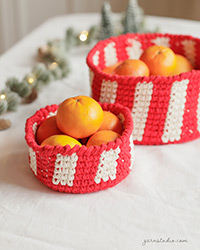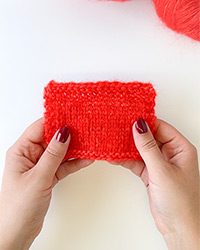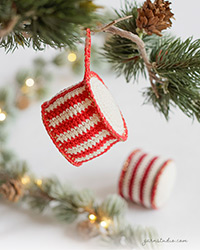Jak na drutach wykonać wzór fal
Wzory, w których została wykorzystana ta technika
Video #107, wymienione w: Naucz się robić na drutach, Ściegi strukturalne na drutach, Fale i zygzaki
Nasze instrukcje video są bez dźwięku. Jesteśmy międzynarodową firmą, a nasze video są oglądane przez ludzi na całym świecie, mówiących różnymi językami, z których wielu nie zna polskiego. Więc skoro nie ma określonego języka, którego moglibyśmy używać, zamiast dźwięku naszym filmom towarzyszą krótkie opisy, a dźwięk nie rozprasza podczas oglądania.
Możesz dostosować prędkość wyświetlania klikając na ikonkę na pasku zadań.
![]() Valeria napisała:
Valeria napisała:
Il video è diverso dalla descrizione del punto; 3 volte 2 maglie insieme, 6 gettate, 3 volte 2 maglie insieme, un ferro dritto, due ferri rovescio ... Cmq bellissimo !
20.11.2013 - 17:11
![]() Stephanie napisała:
Stephanie napisała:
Thank you for your prompt reply.When looking at the video at the stage where the yarn is passed over the needle making a loop to create a stitch on the next row the wool is passed over the needle at the beginning of each stitch and then at the end of the last stitch. IN this clip which uses 6 stitches 7 loops are made. FRom your comment I'll leave the last loop out. Thanks again for your help
02.10.2013 - 19:56DROPS Odpowiedź:
This is how first row in video is worked: K1 edge st, *K2 tog 3 times, yo, K1,yo, K1,yo, K1,yo, K1,yo, K1,yo, K2 tog 3 times*, repeat *-* one more time and end row with K 1 edge st. There are 6 yo made in each repeat, not 7.
02.10.2013 - 20:10
![]() Stephanie napisała:
Stephanie napisała:
I watched your video (Wave pattern 66) and noticed that each pattern increased the stitches by one. This means that subsequent rows of the pattern do not sit immediately above the previous rows of the pattern and the displacement gets worse as you knit the row. When working with over 190 stitches this would seem a problem. Can you please advise. Thank you
02.10.2013 - 13:00DROPS Design Odpowiedź:
Hi Stephanie, No the pattern do not increase by one stitch. For each repeat you make 6 yo's and you K2 tog 6 times. So that evens out. After each row you should have exactly as many sts on the needle as when you started the row.
02.10.2013 - 18:10
![]() Nelly napisała:
Nelly napisała:
Takk for god forklaring:)))
27.09.2013 - 13:50Teresa napisała:
O esquema do ponto ondas 38598 (touca de bebe) está errado.
03.06.2013 - 14:50
![]() Kikine napisała:
Kikine napisała:
Encore milles merci pour votre aide j'ai presque fini mon chauffe épaule et je peu vous dire qu'il enjete mais une question me tarabusque sur qu'elle point dois je rabattre mes mais pour garder ses vagues. Cordialement et encore merci Modéle 136-9
20.04.2013 - 18:05DROPS Design Odpowiedź:
Bonjour Kikine, dans ce modèle,n on rabat à l'endroit (sur l'endroit). Bon tricot !
22.04.2013 - 10:04
![]() Kikine napisała:
Kikine napisała:
Bonjour Je me lance dans le chauffe épaule AMÉLIE, le point vague sur la vidéo est basé sur du jersey , j'ai fait mon échantillon avec un bon rendu. Mais le point vague pour AMÉLIE est basé sur le point mousse ce qui donne un tricot BCq trop aéré échantillon très moche est ce normal ? Puis faire ce tricot sur la base jersey? Cordialement
20.03.2013 - 12:45DROPS Design Odpowiedź:
Pour le modèle 136-9, vous tricotez de la même façon en suivant le diagramme : les m jersey se tricotent à l'end et le point rond dans le diagramme = 1 m env (sur l'end). N'hésitez pas à placer un marqueur entre chaque rapport du diagramme en largeur pour bien vous repérer dans le nombre de mailles. Bon tricot!
20.03.2013 - 14:05
![]() Joelle napisała:
Joelle napisała:
The scallop starts to show once you get the M1 job(that is the wave pattern), it will wave the whole garment. The first 6 rows at the bottom edge are just a regular band. Once the M1 is "on" it will wave more and more. The garment keeps on expanding as we add the YO each side of the marker on every other row, which should be the RS, because we started the wave pattern on the RS.
01.03.2013 - 01:37
![]() Marie napisała:
Marie napisała:
C(est exactement ce que je suis entrain de faire pour un joli pull 22-22 Wonder wave pour mes 3 petites filles et qui sait pour moi plus tard si j'ai encore le temps ! Il m'arrive d'oublier un jetéou de commencer sans une m. endr? mais faire et défaire c'est toujours travailler me disait ma grand-mère !
24.02.2013 - 16:28Zostaw komentarz lub pytanie do tej instrukcji video
Twój adres email nie będzie opublikowany. Pola obowiązkowe są oznaczone *.
























Merci pour ce nouveau point vraiment joli
01.02.2014 - 17:07